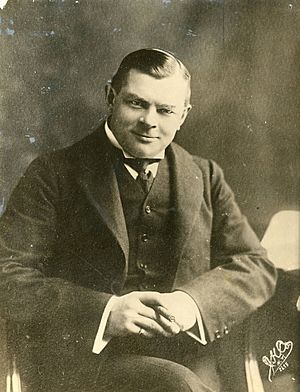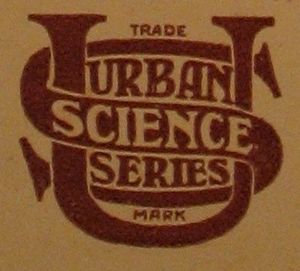Charles Urban facts for kids
Quick facts for kids
Charles Urban
|
|
|---|---|

Urban in 1914
|
|
| Born |
Carl Urban
April 15, 1867 Cincinnati, Ohio
|
| Died | August 29, 1942 England
|
Charles Urban (born April 15, 1867 – died August 29, 1942) was a very important person in early movies. He was an American who moved to England. Before World War I, he was one of the most significant people in British cinema.
Charles Urban helped create many types of films. These included documentaries, educational films, and science films. He also made the world's first successful system for showing movies in colour.
Contents
Early Life and First Jobs
Charles Urban was born Carl Urban in Cincinnati, Ohio. He was the second of ten children. When he was twelve, he lost sight in his left eye because of a baseball accident.
After finishing school in 1882, he changed his name to Charles. He worked selling books across Ohio. Later, he managed a stationery store in Detroit, Michigan.
Starting in the Movie Business
Urban first got into the film industry in 1895. He showed the Kinetoscope in Detroit, Michigan. This was an early device for viewing moving pictures.
In August 1897, he moved to Britain. He became the managing director of the Warwick Trading Company. There, he focused on making "actuality films." These were like early news reports. They included films about the Anglo-Boer War.
Forming His Own Company
In July 1903, Charles Urban started his own company. It was called the Charles Urban Trading Company. In 1908, he moved his business to London's Wardour Street. This street later became the main area for the British film industry. The building, at 89–91 Wardour Street, is still called Urbanora House.
Making Science Fun
In August 1903, Urban launched his 'Unseen World' film show. This show was at the Alhambra Theatre in London. It featured films made with a microscope by F. Martin Duncan. These films showed tiny things up close.
People had never seen scientific films presented as entertainment before. But the show was a big hit! A popular film was Cheese Mites. It showed tiny mites crawling on a piece of Stilton cheese. 'The Unseen World' ran for nine months. This showed Urban that science and educational films could be entertaining.
Other Types of Films
The Charles Urban Trading Company made many non-fiction films. These included travel films, war reports, and exploration films. They also made sports films, advertisements, and nature films.
Many talented filmmakers worked for Urban. One of them was F. Percy Smith, a naturalist. Smith made a very popular film for Urban called The Balancing Bluebottle (1908). It showed a fly balancing objects like a wine cork with its legs.
Urban also made a long documentary film in 1906. It was called The Streets of London. This film showed Londoners going about their daily lives. Some footage found in Australia in 2007 might be from this film. Other experts think it's from his 1904 documentary, Living London.
He also produced fiction films. Some notable examples were early science fiction films by Walter R. Booth. These included The Airship Destroyer (1909) and The Aerial Submarine (1910).
Urban had other business interests too. He started a French film company in Paris called Éclipse in 1906. This company mainly made fiction films. He also created Kineto Limited in 1907. Kineto focused on making scientific and non-fiction films.
Kinemacolor: Movies in Color!
In 1906, Urban's friend George Albert Smith developed a new system. It used two colors (red and green) to show movies. Urban launched this system in May 1908. From 1909, it became known as Kinemacolor.
Kinemacolor was very successful around the world until 1914. Urban's most famous Kinemacolor film was a long movie called With Our King and Queen Through India (1912). It was also known as The Durbar in Delhi. This film showed the December 1911 Delhi Durbar. This event celebrated the coronation of King George V.
Kinemacolor companies were started in many countries. These included France, the US, Germany, and Japan. The Kinemacolor Company of America was the most well-known. Urban also made Kinemacolor fiction films. He had studios in Hove and Nice. Some films included By Order of Napoleon (1910) and Santa Claus (1912).
The End of Kinemacolor
Urban's Kinemacolor business ended in 1914. This happened after a court case. William Friese-Greene, who had a rival color system, challenged Kinemacolor's patent. Urban won the first court case. However, the decision was overturned on appeal.
A judge explained that the Kinemacolor patent was not valid. This was because it didn't fully reproduce all natural colors, especially blue. Even though Kinemacolor could still be used, it was no longer special. It lost much of its value. Urban made his last Kinemacolor film in 1915.
World War I and Propaganda Films
During World War I, Urban worked for British propaganda groups. These groups aimed to influence public opinion. He produced a documentary called Britain Prepared (1915). This film showed the British fleet.
Urban helped promote this film in America. He also promoted other British propaganda films. It was hard at first because many US movie theaters didn't want to show war propaganda.
His job became easier when America joined the war in April 1917. Urban edited the famous documentary The Battle of the Somme (1916). He made the important decision to release the footage as one long film. This was instead of many short clips. Urban continued to edit and promote British documentaries in America until the war ended. He also started a new business, the Kineto Company of America, in 1917.
Later Life
After the war, Urban stayed in the United States. He wanted to become a producer of educational films. He started a company called Urban Motion Picture Industries Inc.
He produced movie series like Charles Urban Movie Chats (starting 1919) and Kineto Review (starting 1921). He also made documentaries such as The Four Seasons (1921) and Evolution (1923).
Urban built a large studio in Irvington, New York. He planned to introduce a new color film system there. It was called Kinekrom and was based on his earlier Kinemacolor. However, his businesses failed in 1924. He returned to the UK in the late 1920s. Charles Urban died in Brighton in 1942, at age 75. He was not as famous then as he had been.


